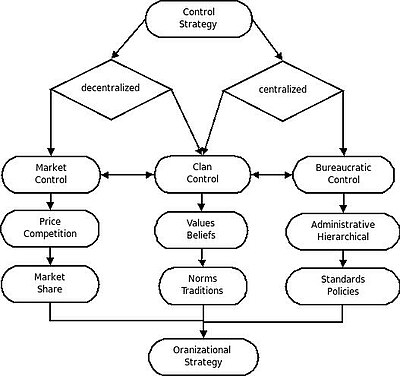Control theory (sociology)
Appearance
| Part of a series on |
| Sociology |
|---|
 |

Control theory in
bureaucratic control. Some types of control such as clan
control are considered to be a mixture of both decentralized and centralized control.
Decentralized control or market control is typically maintained through factors such as
values
and beliefs or norms and traditions.
Containment theory, as developed by
deviant
behavior.
Control theory stresses how weak bonds between the
conforming
to social norms. Social bonds are used in control theory to help individuals from pursuing these attractive deviations.
According to Travis Hirschi, humans are selfish beings, who make decisions based on which choice will give the greatest benefit. A good example of control theory would be that people go to work. Most people do not want to go to work, but they do, because they get paid, to obtain food, water, shelter, and clothing.
Hirschi (1969) identifies four elements of social bonds: attachment, commitment, involvement, and belief.[2]
See also
Notes
- ^ Martin, Asher (March 11, 2010). Control Theory Flow Chart Archived 2012-03-04 at the Wayback Machine.
- ISBN 978-0-520-01901-0.
References
- Giddens, Anthony, Mitchell Duneier, Richard Appelbaum, and Deborah Carr. Introduction To Sociology. Seventh . New York City: W.W. Norton & Company, 2009. 182. Print.
- Hamlin, John. "A Non-Causal Explanation: Containment Theory Walter C. Reckless." 2001. University of Minnesota, Web. 5 Mar 2010. <https://web.archive.org/web/20110604223724/http://www.d.umn.edu/cla/faculty/jhamlin/2311/Reckless.html>.
- O'Grady, William. Crime in a Canadian Context. 2011. Toronto: Oxford University press. Print.
- Henslin, James M. Sociology: A Down-To-Earth Approach. Nine ed. Boston: Allyn and Bacon, 2008. Print.
